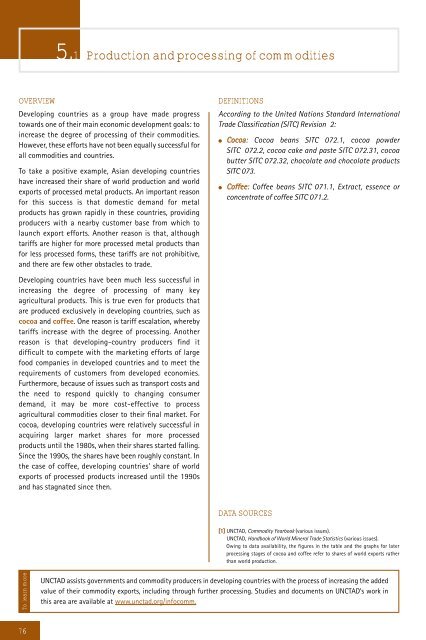Development and Globalization: - Unctad
Development and Globalization: - Unctad
Development and Globalization: - Unctad
You also want an ePaper? Increase the reach of your titles
YUMPU automatically turns print PDFs into web optimized ePapers that Google loves.
OVERVIEW DEFINITIONS<br />
Developing countries as a group have made progress<br />
towards one of their main economic development goals: to<br />
increase the degree of processing of their commodities.<br />
However, these efforts have not been equally successful for<br />
all commodities <strong>and</strong> countries.<br />
To take a positive example, Asian developing countries<br />
have increased their share of world production <strong>and</strong> world<br />
exports of processed metal products. An important reason<br />
for this success is that domestic dem<strong>and</strong> for metal<br />
products has grown rapidly in these countries, providing<br />
producers with a nearby customer base from which to<br />
launch export efforts. Another reason is that, although<br />
tariffs are higher for more processed metal products than<br />
for less processed forms, these tariffs are not prohibitive,<br />
<strong>and</strong> there are few other obstacles to trade.<br />
Developing countries have been much less successful in<br />
increasing the degree of processing of many key<br />
agricultural products. This is true even for products that<br />
are produced exclusively in developing countries, such as<br />
cocoa <strong>and</strong> coffee. One reason is tariff escalation, whereby<br />
tariffs increase with the degree of processing. Another<br />
reason is that developing-country producers find it<br />
difficult to compete with the marketing efforts of large<br />
food companies in developed countries <strong>and</strong> to meet the<br />
requirements of customers from developed economies.<br />
Furthermore, because of issues such as transport costs <strong>and</strong><br />
the need to respond quickly to changing consumer<br />
dem<strong>and</strong>, it may be more cost-effective to process<br />
agricultural commodities closer to their final market. For<br />
cocoa, developing countries were relatively successful in<br />
acquiring larger market shares for more processed<br />
products until the 1980s, when their shares started falling.<br />
Since the 1990s, the shares have been roughly constant. In<br />
the case of coffee, developing countries’ share of world<br />
exports of processed products increased until the 1990s<br />
<strong>and</strong> has stagnated since then.<br />
To learn more<br />
76<br />
5.1 Production <strong>and</strong> processing of commodities<br />
According to the United Nations St<strong>and</strong>ard International<br />
Trade Classification (SITC) Revision 2:<br />
● CCooccooaa: Cocoa beans SITC 072.1, cocoa powder<br />
SITC 072.2, cocoa cake <strong>and</strong> paste SITC 072.31, cocoa<br />
butter SITC 072.32, chocolate <strong>and</strong> chocolate products<br />
SITC 073.<br />
● CCooffffeeee: Coffee beans SITC 071.1, Extract, essence or<br />
concentrate of coffee SITC 071.2.<br />
DATA SOURCES<br />
[1] UNCTAD, Commodity Yearbook (various issues).<br />
[1] UNCTAD, H<strong>and</strong>book of World Mineral Trade Statistics (various issues).<br />
Owing to data availability, the figures in the table <strong>and</strong> the graphs for later<br />
processing stages of cocoa <strong>and</strong> coffee refer to shares of world exports rather<br />
than world production.<br />
UNCTAD assists governments <strong>and</strong> commodity producers in developing countries with the process of increasing the added<br />
value of their commodity exports, including through further processing. Studies <strong>and</strong> documents on UNCTAD’s work in<br />
this area are available at www.unctad.org/infocomm.

















